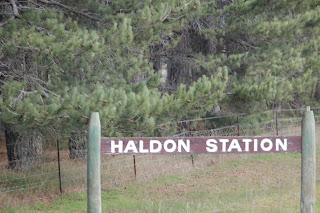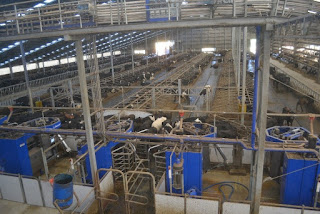Day 9
 |
| This was the first stop of the day the Tin Shed store of wool and wool products. |
The group departed the hotel in Ashburton, and traveled
across the Canterbury plains, stopping at the Tin Shed. The Tin Shed is a
specialty store that focuses on wool and wool products. Many members of the
group enjoyed purchasing authentic merino sweaters and socks. Also at the Tin
Shed, there was a small variety of animals around the farm such as: alpacas,
pigs, donkeys, and chickens. After we were finished purchasing souvenirs, we
got on the bus and traveled to Geraldine. In Geraldine, we had many
opportunities to get lunch, check out a fudge store, and many shops to browse
through. While in Geraldine, many
students took the opportunity to look at local scenery.
 |
| Alpaca that was outside of the Tin Shed. |
After leaving Geraldine, we traveled through Canterbury Plains, which suddenly changed to the Mackenzie region. With this change, the plains turned into rolling hills with a large change in altitude from 800 meters to 1300 meters. The focus of our day was a tour of the Haldon Station.
 |
| Entrance sign of Haldon Station. |
The Haldon Station is a 22,000-hectare sheep, beef and red
deer farm. Haldon Station is owned by Hans and Jenny Klisser, and managed by
Paddy Boyd and his wife Barbara. Along with Paddy and Barbara, there are five
single employees and five married couples employees. All animals at Haldon
Station are grazed outdoors in open pastures all year round, and fed purely on
grasses plus some hay and grain supplementation in the very cold winter months.
The pastures range from irrigated ryegrasses to high country native tussock.
There are 12,000 merino sheep, 6,000 red deer, and 1,200
beef cattle on the farm. The farm dates back all the way to the 1850’s when a
Dutch pioneer, Thomas Teschmaker, along with his brother and mother, first
claimed a 20,000-acre run they named Haldon. Over the years, Haldon Station has
went through many different owners. Since the Klissers bought the station,
Haldon has undergone some major changes and has improved into what it is
today.
 |
| Inside of the shed that is used to process deer and remove the velvet. |
Something
that we thought was very interesting was that they started their deer farm by
capturing wild deer, taming them and teaching them to be farm deer. They first
used tranquilizing darts, and then moved into using net guns from helicopters.
Since that era, the genetics have greatly improved with the establishment of an
on-farm breeding program with the selection of only top performing animals
entering the breeding program. Haldon deer are known for their quiet tempered,
quality body weights and velvet yields. When looking at the whole scope of the
farm, the deer make up 15% of the property but 50% of the profits. One of the things that we got to tour was a
“deer shed” where they would process the deer and remove the velvet.
 |
| Katelyn Groetsch enjoying Haldon Station. |
The views from Haldon Station were absolutely breath
taking.
 |
| Group at Haldon Station. |
 |
| Group at Lake Tekapo. |
After we left Haldon Station, we made our way to the Lake Tekapo, to get a photo opportunity of the iconic lake.
 |
| The water in this lake was very clear. |
 |
| Tonight we celebrated Kylie Lessman’s 21st birthday with cake during dinner. |
Kia Ora !
With love,
Kylie, and Jason




Comments
Post a Comment